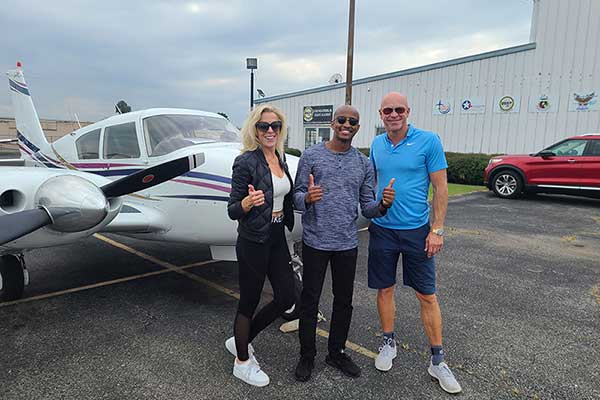WHY BE GREAT WHEN YOU CAN BE EXCEPTIONAL?
Flight training to the highest standards to elevate your career or love of flying to the next level.

About Stephanie:
Stephanie is an MEI with experience training pilots of all ages and experience levels on how to fly multi-engine and single-engine aircraft. Her true love and passion is in multi-engine planes where she flies a Piper Twin Comanche and Citation V – and previously a Citation I Stallion.

WHAT FLIGHT TRAINING IS LIKE:
Flying and learning is meant to be fun and challenging and that’s what you’ll get when learning from Stephanie. You will enjoy the faster aircraft and learning environment with a flight instructor teaching you and pushing you to be better. Developing your multi-engine skills is meant to be an enjoyable experience while pushing you out of your comfort zone to attain elevated skills you never dreamed of. That’s what this course will be like. Stephanie is patient, kind, fun and will push you to have the highest level standards in aviation and for yourself personally. Your training will go beyond memorization and proficiency for the checkride. It will make you a better pilot, decision-maker, and safety-conscious aviator. And there will be plenty of fun had along the way!
MULTI-ENGINE FLIGHT TRAINING
Multi-engine commercial add-on rating and complex endorsement.
(Requirement: Must have a single engine private pilot certificate or single engine commercial certificate.)
Aircraft Details
- AIRCRAFT YOU WILL TRAIN IN: Piper Twin Comanche PA-30.


- SPECS: 320 hp IO-320-B Lycoming engines (160 hp each engine).
- Fuel Tanks: Main tanks - 60 gal. total (54 gal. usable). Auxiliary tanks - 30 gal. total (all usable). 90 gal. in aircraft (84 usable).
- Retractable gear. Brand new interior.
- EQUIPMENT/AVIONICS: Garmin 430, two Garmin G 5's, and auto-pilot.
Length of Training
5-8 days (buffer days in case of unexpected weather or mechanical problems)Pricing
$375/hr for instruction, training, aircraft and fuel
$50/hr for ground school
Pass Rate
To date: 100%
Here are photos from some of our many successful checkrides. Congratulations pilots!




Documents
- Twin Comanche Pilot Operating Handbook (POH)
- Multi-Engine Operations
- Constant Speed Propeller System
- The Drill
- The 'Drill' - This is the procedure at the core of multi-engine operations and it's one of the most important parts of multi-engine flying. It is the procedure you do if/when an engine fails in flight. Chair fly this at home - if you can - to start getting this memorized. If an engine goes out:
Simultaneously push all power controls forward and stabilize the aircraft by applying opposite rudder to make the nose go straight.
- Throttles - FORWARD
- Propellers - FORWARD
- Mixture - FORWARD
- Gear - UP
- Flaps - UP
- Fuel pumps - ON
- Stabilize - RAISE THE DEAD ENGINE 2-5 DEGREES INTO THE OPERATING ENGINE (for straight flight)
- Then...
- Identify - DEAD LEG DEAD ENGINE
- Verify - THROTTLE BACK DEAD ENGINE
- Fix or Feather - PULL PROPELLER BACK TO FEATHER
- Stabilize - RAISE THE DEAD ENGINE 2-5 DEGREES INTO THE OPERATING ENGINE
- The 'Drill' - This is the procedure at the core of multi-engine operations and it's one of the most important parts of multi-engine flying. It is the procedure you do if/when an engine fails in flight. Chair fly this at home - if you can - to start getting this memorized. If an engine goes out:
Simultaneously push all power controls forward and stabilize the aircraft by applying opposite rudder to make the nose go straight.
- ACS (Airman Certification Standards)
- Commercial ACS (Airman Certification Standards)
Syllabus
Most flight lessons will consist of a mix of multi-engine pattern work, maneuvers, and engine out drills. You still start with getting familiar with the aircraft, learning all the maneuvers, takeoffs and landings, engine out situations, then refine the areas that need work.
General Schedule of Training
- DAYS ONE – TWO: Check-in starts with a review of logbook and qualification requirements, identification, and payment.
Ground training will consist of learning about the Twin Comanche systems, constant speed propellor functions, and multi-engine operations.
Flight training – Takeoffs, landings, pattern work, slow flight, steep turns, power on stalls and power off stalls. - DAYS THREE – FOUR: Flight training – Vmc demo, engine-out at altitude, takeoffs, landings, and pattern work.
- SUBSEQUENT DAYS: Engine failure on runway, engine shutdown at altitude, engine restart at altitude, engine out instrument approach, engine out in the pattern, go-around, short field takeoff, and short field landing.
These lessons are a guide for the week-long training. Every student works, learns and retains differently. How each student gets to their successful checkride varies but each student will ultimately receive all of the necessary ACS (Airmen Certification Standards) checkride training and will be taught proficiently, to the highest standard, and beyond the checkride. Our mission is to take you beyond the ACS and flight standards you need to meet for the checkride and for you to truly be comfortable and proficient flying multi-engine aircraft. This training will elevate you past your peers as you move forward in your career because you will learn more than just multi-engine operations. You will learn how to be a better decision-maker, pilot, and safety-conscious aviator.
Checkride
Checkride practical/flight portion length: approx. 1.3-1.8 flight hours. We work with several DPE's locally and will coordinate the checkride for you. Cost: ~$800.00.
SUCCESSFUL CHECKRIDES




Contact Us

